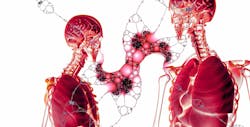Stroke patients with COVID-19 have increased inflammation, stroke severity and death
Stroke patients who also have COVID-19 showed increased systemic inflammation, a more serious stroke severity and a much higher rate of death, compared to stroke patients who did not have COVID-19, according to University of Alabama at Birmingham (UAB) research led by Chen Lin, MD, an assistant professor in the UAB Department of Neurology.
The research, published in the journal Brain, Behavior & Immunity – Health, is a retrospective, observational, cross-sectional study of 60 ischemic stroke patients admitted to UAB Hospital between late March and early May 2020. Ischemic stroke occurs when a blood vessel for the brain is blocked by a clot, depriving some brain tissue of oxygen. All patients were tested for COVID-19 at admission.
The UAB researchers mined electronic medical records of confirmed stroke cases for information on age, gender and race; clinical variables; laboratory data, including complete blood counts, blood chemistry and coagulation tests; and outcomes, including death, length of hospital stay and condition at discharge.
The ratio of the number of neutrophils to the number of lymphocytes, or the NLR, as calculated from blood count data, served as an index of the systemic inflammatory response. While other researchers have associated NLR with COVID-19 disease severity, refractory disease and even as an independent factor for mortality, “our study is the first to associate the NLR in patients with COVID-19 and ischemic stroke and stroke severity,” Lin said. Of the 60 hospitalized patients with acute systemic stroke, nine were positive for a COVID-19 infection.
The UAB research had four major findings. First, patients who were positive for COVID-19 presented with a more severe neurological deficit at admission, as measured by the National Institutes of Health Stroke Scale, or NIHSS, score, which averaged 18.4. Second, all patients with an NIHSS score higher than 4 — including uninfected patients — had a significantly higher NLR than those with lower scores. The NIHSS is used to predict lesion size and gauge stroke severity. Third, patients with COVID-19 had an increased inflammatory response, including significantly higher neutrophil counts, lower lymphocyte counts and an increased NLR, compared with uninfected patients. Finally, stroke patients with COVID-19 had a significantly higher mortality rate — 44.4 percent, versus 7.6 percent for uninfected stroke patients.

